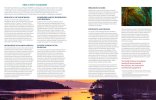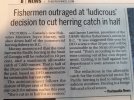Category(s):
COMMERCIAL - Herring Special Usestyle='mso-special-character:line-break'>
Fishery Notice - Fisheries and Oceans Canada
Subject: FN1345-2021/2022 Special Use Herring Fishery Opening - December 20, 2021 - Amendment to FN1344
This notice amends FN1344. Options for the transfer of additional TAC up to 902 tons are under consideration, and changes will be provided in subsequent fishery notices. The full corrected fishery notice follows.
The 2021/2022 Pacific Herring Commercial Fishing Plan for the Special Use fishery was circulated for review from October 15 to November 14, 2021. Thank you to those that submitted advice and recommendations for the plan during this period, the plan has now been finalized and the approved commercial plan can be found here: href="
https://www.dropbox.com/s/txs1pcbehe2kidg/APPROVED 2021_2022 Special Use Fishing Plan.pdf?dl=0">
https://www.dropbox.com/s/txs1pcbehe2kidg/APPROVED 2021_2022 Special Use Fishing Plan.pdf?dl=0
An interim allocation of 451 short tons has been approved for the Strait of Georgia management area only. Options for the transfer of additional TAC up to 902 tons are under consideration, and changes will be provided in subsequent fishery notices.
As per Variation Orders #2021-526 and #2021-527, the Special Use fishery will open to fishing at 18:00 hours on December 20, 2021 until February 15, 2022. Fishing is permitted in portions of Area 12, 13, 14, 15, 16 and 17 excluding the following areas which remain closed and subject to any additional constraints listed in individual conditions of license:
That portion of Subarea 12-4 inside a line running from Lewis Point to Ella Point [Beaver Cove];
Subarea 12-20 [Parson Bay];
That portion of Subarea 12-3 from a point on shore due North to a point at 50°30.33' N 126°37.47' W then East to a point at 50°29.65' N 126°30.23' W then due South to the shoreline [Robson Bight - Michael Bigg Ecological Reserve from a point on shore due North to a point at 50°30.33' N 126°37.47' W then East to a point at 50°29.65' N 126°30.23' W then due South to the shoreline (Robson Bight - Michael Bigg Ecological Reserve)
That portion of Subarea 13-7, East of a line drawn from a boundary sign at 50°11.4 34'N 125°20.268'W to a boundary sign at 50°10.861' N 125°20.885' W near Separation Head on Quadra Island [Deepwater Bay]
Subarea 14-14 [Comox Harbour]
Subarea 16-3 [Bargain Bay];
Subarea 16-4 [Pender Harbour];
Subarea 16-5 [portion of Sechelt Inlet];
That portion of Subarea 16-10 within a radius of 0.3 nautical miles from the mouth of Sakinaw River.
Subareas 17-1 to 17-9;
That portion of Subareas 17-10 and 17-17 described as the waters of Gabriola Pass bounded by a line from Dibuxante Point at 49°07.625'N and 123°42.913'W on Valdes Island, thence following the Northerly shore of Valdes Island to Cordero Point at 49°07.7002N and 123°42.1262W on Valdes Island, thence to the most Southerly tip of Breakwater Island at 49°07.5462N and 123°40.8972W, thence following the Westerly shore of Breakwater Island to the most Northerly point on Breakwater Island at 49°08.360'N and 123°40.872'W, thence due West to Gabriola Island at 49°08.355'N and 123°41.4770'W, thence following the Southerly shore of Gabriola Island to the point of land located at 49°07.777'N and 123°43.045'W, thence in a straight line Southerly to the point of commencement at Dibuxante Point;
Subarea 17-14 [Nanaimo Harbour];
That portion of Subarea 17-16 South of a line at Dodd Narrows, drawn from Joan Point at 49°08.150'N 123°49.145'W on Vancouver Island Easterly to Purvis Point at 40°08.174N 123°49.016'W on Mudge Island;
Subarea 17-20 [Nanoose Harbour]
ELECTRONIC MONITORING:
In light of the ongoing COVID-19 pandemic, an alternative to at-sea observers will be available during the 2021/2022 fishing season. This will include the use of video and electronic monitoring (EM) systems on board vessels. Please note: arrangements for at-sea observer services or EM installation shall be made by contacting the service provider at 604-291-6340 (between 08:00 h and 16:00 h, Monday to Friday, excluding statutory holidays) at least 72 hours in advance of the intended time of departing port.
Licence holders and vessel masters are advised to fully review the licence conditions that address EM requirements.
FOR MORE INFORMATION:
Marisa Keefe, Regional Herring Officer
href="mailto:
Marisa.Keefe@dfo-mpo.gc.ca">
Marisa.Keefe@dfo-mpo.gc.ca
Fisheries and Oceans Canada Operations Center - FN1345
Sent December 20, 2021 at 15:12
Visit us on the Web at href="
http://www.pac.dfo-mpo.gc.ca">
http://www.pac.dfo-mpo.gc.ca
If you would like to unsubscribe, please submit your request at: href="
http://www-ops2.pac.dfo-mpo.gc.ca/fns-sap/index-eng.cfm?pg=manage_subscription">
http://www-ops2.pac.dfo-mpo.gc.ca/fns-sap/index-eng.cfm?pg=manage_subscription
If you have any questions, please contact us via e-mail to: href="mailto:
DFO.PACOpsCentre-CentredesOpsPAC.MPO@dfo-mpo.gc.ca">
DFO.PACOpsCentre-CentredesOpsPAC.MPO@dfo-mpo.gc.ca


